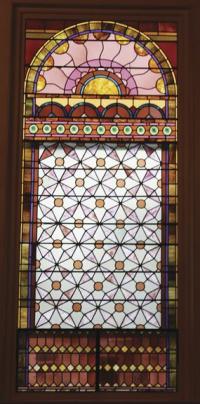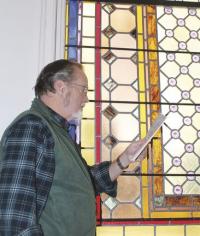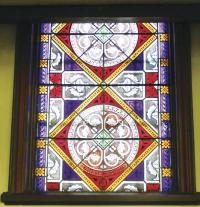
Serving the Vermont Champlain Valley Area for 45 Years
Main SectionsFront Page SportsValley VitalsIt's in the StarsStarwiseArchivesLinksAbout The VoiceContact Us |
Illuminations In Glass: Examining The Art Of Stained Glass WindowsTuesday February 26, 2013 By Cookie Steponaitis The beauty of stained glass was first seen in Roman villas and has come down through the centuries to adorn homes, houses of worship and occupies a spot in the hearts and souls of billions around the planet. World Cultures students at VUHS examined the relevance of these illuminations in glass and recently went on a field trip in Vergennes viewing modern stained glass windows and comparing them to some of their medieval counterparts located in Europe. Although stained glass was not invented during the Middle Ages its use and implementation was the passion of one man. The monk Suger was born in 1081 and single handedly changed the role of stained glass in the cathedrals of Europe and introduced the Gothic style of architecture. God’s presence meant light to Suger and he used the Church of Saint Denis located near the heart of Paris as his showcase transforming it into a place where worshippers could feel the presence of God. He used stained glass on a scale never previously imagined and opened up the choir at Saint Denis to let in light from floor to ceiling. His vision of a curtain of glass transformed not only the use of stained glass but the way in which the church was constructed. Referring to his vision as, “the light of divine illumination,” Suger saw the role of the windows as not only creating an environment of worship and awe but as a teaching tool and a three dimensional way to understand the religion at a time when most of the people could neither read or write. The students were surprised to see the variety of applications of stained glass in different locations when visiting local churches in Vergennes. The students learned that Saint Peter’s church was built in 1874 for a cost of $2500.00 and like many buildings of the city the brick for the structure came from the local brick yard. The stained glass windows were given by different individuals over time to the church, depict Biblical scenes and have small plaques showing the names and dates of the window’s creation and donors. Struck by the height of the vaulted ceilings and number of stained glass windows, each student sketched a window of their choice and wrote notes in reference to the specific history of the window and church that was provided by church historian F. Ann Sullivan. Other churches like the Congregational Church on South Water Street presented the students with images of a church with plain glass windows and then the introduction of the stained glass windows over a period of time. The Congregational Church was constructed in 1834 for a cost of approximately $3,600.00 and its windows do not show depictions of people or any physical representation of Bible scenes but are full of symbolic representations of the numbers of apostles, certain sacraments and other holy representations. Church member and historian Mike O’Daniel provided the students with not only a tour of the windows but the process, cost and re -leading of windows. Students learned how a local glass specialist came to the church, took out specific windows and made the repairs there at the church replacing them with extra supports and precautions for their continued display. The Episcopal Church on Main Street offered students yet another approach to the use and display of stained glass. Windows in this church as explained by church member Lenore Morse offered some of the deepest hues of greens, reds, whites and blues in the tour and left students in awe of the pools of light reflecting on the floor of the church. The students returned to VUHS and wrote up their observations and selected specific windows from cathedrals in Europe to research and reflect on. Each student created for themselves in blogs and essays their own vision of the history of stained glass and its presence in our lives today. These illuminations or walls of light intersect the past with the present and not only opened their eyes about the history of the art form but provided them the opportunity to meet a local stained glass artist and to understand the connection to the modern world today. Whether in a church, home, business or museum the combination of stained glass and light has showcased the power of nature and brightened the hearts of billions the world over. World Culture students can link the world of Abbot Suger to the twenty-first century; trace the evolution of an art form, the Gothic style of architecture and its appearance in small towns in Vermont today. Stained glass is beautiful to the eye, pleasing to the heart and a wonder in its construction and its ability to bring the power of faith through time and place linking generations across time.
|
AdvertisementsSearch our Archives |
Agricultural Weather Forecast:

© 2006-18 The Valley Voice • 656 Exchange St., Middlebury, VT 05753 • 802-388-6366 • 802-388-6368 (fax)
Valleywides: [email protected] • Classifieds: [email protected] • Info: [email protected]



 Printer Friendly
Printer Friendly